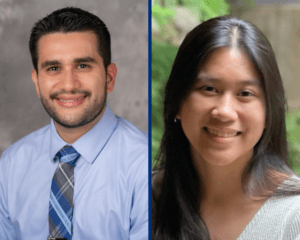Disordered thermoelectric materials—which convert heat into electricity—are crucial to the work of the National Aeronautics and Space Administration (NASA). In addition to powering generators in NASA spacecraft since the 1960s, these materials are used in sensors for temperature and radiation detection and in cooling systems on spacecraft. However, the efficiency of disordered thermoelectric materials varies depending on the conditions and materials involved.
“The ability to capture excess heat and turn it into electricity is sort of a holy grail for energy, so finding new materials that can do this conversion more efficiently and economically is a really big need,” said Corey Oses, an assistant professor in the Department of Materials Science and Engineering and an associate of the Ralph O’Connor Sustainable Energy Institute (ROSEI).

Corey Oses and Katie Cariaga
Oses and Katie Cariaga, a first-year student studying materials science and engineering and computer science, are working to solve this problem through the creation of a first-of-its-kind database they believe will accelerate the discovery of new disordered thermoelectric materials by shedding light on how they work.
The publicly accessible database of disordered thermoelectrics will reveal how atoms are arranged and interact in these materials. The project, supported by the 2023 Maryland Space Grant Summer Internship Program, will begin this summer.
“The more features we discover about these materials, the more accessible we make them for researchers with specific needs,” Oses said. “Imagine being sent to the supermarket to buy groceries: The more specific the list, the better you can match a recipe you’re going to try at home.”
Intern Cariaga will spend the summer extracting new computational fingerprints that help map microscopic features of these materials to the properties researchers want to observe in the lab.
“For each material we want to test, I will simulate several of its structural and chemical features. Then I will put all our results together, creating this first-ever database,” Cariaga said. “We can use this bank to match materials that are made in the lab, so, people can rapidly identify new more efficient disordered materials rather than relying on guesswork. This will help push advancements in sustainable energy materials.”
Oses says this project is “just the beginning” of a larger collaboration between his Entropy for Energy Laboratory and colleagues working at the Johns Hopkins Applied Physics Lab (APL). He and Rama Venkatasubramanian, chief technologist for APL’s thermoelectric research area, will assist Cariaga during her summer work by creating feedback loops, which allow computer systems to know what they did right or wrong, providing parameters that will allow the system to perform better in the future. The feedback loops will be created between Cariaga’s experiments and computations with the hope of making her work even more precise as she continues, leading to the goal of designing the next generation of thermoelectric devices.
“Our collaboration with APL starts with this proposal and will grow into much bigger efforts,” Oses said. “Essentially, we are both aiming to couple computer and materials science and create a systematic path to better-performing thermoelectric materials.”